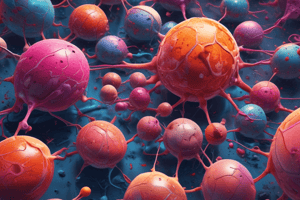Podcast
Questions and Answers
What is the characteristic appearance of caseous necrosis in the lung?
What is the characteristic appearance of caseous necrosis in the lung?
- Fibrinous and layered
- White and cheese-like (correct)
- Liquid and viscous
- Yellowish and nodular
What is the term for programmed cell death or cellular suicide?
What is the term for programmed cell death or cellular suicide?
- Apoptosis (correct)
- Liquefactive necrosis
- Fibrinoid necrosis
- Necrosis
Which of the following is a normal physiological function of apoptosis?
Which of the following is a normal physiological function of apoptosis?
- Cell turnover during tissue involution (correct)
- Elimination of infected cells
- Accumulation of misfolded proteins
- Response to radiation treatment
What is the term for the destruction of fat cells, often seen in the mesentery?
What is the term for the destruction of fat cells, often seen in the mesentery?
What is the term for the process of cellular suicide in response to DNA damage or viral infections?
What is the term for the process of cellular suicide in response to DNA damage or viral infections?
What is the term for the material that herniates through the buccal mucosa in a 3-year-old male?
What is the term for the material that herniates through the buccal mucosa in a 3-year-old male?
Flashcards are hidden until you start studying
Study Notes
Necrosis Types
- Liquefactive necrosis: characterized by digestion of dead cells, resulting in a liquid, viscous mass, often seen in abscesses on the skin.
- Caseous necrosis: displays a white, cheese-like appearance of dead cells, commonly associated with tuberculosis in the lung.
- Fibrinoid necrosis: typically seen in immune reactions within blood vessels, often occurring in conditions like Behcet syndrome, which is characterized by systemic vasculitis, oral ulcers, genital ulcers, skin lesions, and ocular lesions.
- Fat necrosis in the mesentery: not a true necrotic pattern, but rather focal areas of fat destruction, often seen in herniated buccal fat pads.
Apoptosis
- Programmed cell death or cellular suicide, tightly regulated to maintain homeostasis.
- Distinct from necrosis, with no significant inflammatory reaction, no loss of cell membrane integrity, and no leakage of cellular contents.
- Apoptosis can coexist with necrosis.
Apoptosis in Normal Processes
- Embryogenesis: cell elimination due to loss of growth factor signaling.
- Normal cell turnover: elimination of cells with short half-lives, and tissue involution due to loss of growth factor stimulation or hormonal changes (e.g., in the endometrium during the menstrual cycle).
- Immune function: decline in leukocytes at the end of inflammation, and elimination of harmful self-reactive lymphocytes.
Pathologic Apoptosis
- DNA damage: activates proapoptotic proteins, often triggered by radiation treatment or cytotoxic drugs.
- Accumulation of misfolded proteins: activates proapoptotic proteins and caspases (cysteine proteases).
- Infections: viral infections, such as adenoviruses, herpesviruses, EBV, and HHV-8, can activate proapoptotic proteins or caspases.
- Killing of infected cells: cytotoxic T lymphocytes (CTLs) activate caspases, leading to apoptosis.
Studying That Suits You
Use AI to generate personalized quizzes and flashcards to suit your learning preferences.




